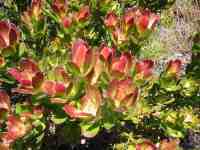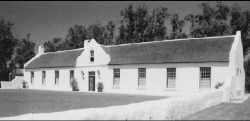
 |
South Africa West CoastWest Coast National Park |
|
West Coast Explorer SA West Coast Tours/Recreation West Coast Map Fossil Park Sea Tales & Wrecks Whale Watching Guriqua History Weskus Stories West Coast R27 Route 27 West Coast Towns Off the Beaten Track Culture & History From Crayfish to Iron |
The West Coast National Park and Langebaan lagoon has much to offer the visitor whether he/she is interested in archaeology, flora and fauna, bird watching, fossils, history of the area or just wonderful sites and views.
ArchaeologyFossil deposits extending some 20 million years ago into the past have been found in the vicinity of the Park. The oldest human remains south of the Orange River have been found on the Farm Elandsfontein. More recently, some 117 000 years ago a lone female trudged down a steep dune to the lagoon leaving her footprints in the wet sand. Within a few hours the dune dried out and the wind filled in the footprints with sand encasing them. Over those thousands of years more layers of sand were deposited over the footprints. The sandstone cliff collapsed and exposed those footprints. They were discovered in 1995 and were named “Eve’s Footprints” - Eve because she may have been the ancestor of modern woman. The site where the footprints were discovered may be seen today.Konstabel Kop, one of the highest points in the Park, was very recently discovered to be an extinct volcano, which blew its top over 500 million years ago. Flora and Fauna Many visitors describe the display of wild flowers in the Park as breathtaking. Areas of the Park are blanketed with flowers of many different shades and hues. The wild flower display can be seen anytime between July and October and the best time is very much dependent upon the weather. The time of year when the flowers are usually at their best is during the months of August and September. It is interesting to note that the colour patterns change from week to week as flowers fade and other varieties come into bloom. Many visitors describe the display of wild flowers in the Park as breathtaking. Areas of the Park are blanketed with flowers of many different shades and hues. The wild flower display can be seen anytime between July and October and the best time is very much dependent upon the weather. The time of year when the flowers are usually at their best is during the months of August and September. It is interesting to note that the colour patterns change from week to week as flowers fade and other varieties come into bloom.Eland, gemsbok, bontebok, springbok, wildebeest, kudu and Cape mountain zebra are found in Postberg, a privately owned area of land, which is managed contractually by the Park. This area of land is open to the public during the months of August and September. Currently a fence is being erected on the Park’s southern boundary and many of the above antelopes will be introduced into the Park once the fence is completed, which should be within the next six months. Other animals to be found in the Park include steenbok, duiker, grey reebok and hartebeest. The largest of the small cat family, the caracal or rooikat, is present and is occasionally seen during the day, although late evening is the best time for viewing. Many other mammals such as the African wild cat, genet and bat-eared fox may also be found. BirdsThere are approximately 250 bird varieties to be found - both resident and migratory. Some of the migratory birds include greater and lesser flamingoes and waders; the latter including curlew sandpipers, sanderlings and knots, migrate from Siberia and Greenland and spend the summer here. The attraction for them is the salt marshes at the southern end of the lagoon, the largest of its kind in Africa. A few years ago a sanderling in Russia was weighed at 25 grams and tagged prior to its migration to the lagoon, was caught and weighed after its arrival. It weighed 15 grams - obviously an exhausting journey! There are 3 bird hides that are available to visitors.History The area is rich in historical events from the first inhabitants, the Khoikhoi and San to the arrival of the Europeans. The first European to set foot on land was Vasco da Gama at St Helena Bay on the West Coast Peninsula in 1497. Antonia de Saldanha, after whom the bay is named, did not enter those waters at all. Juris van Spilbergen mistakenly named it in 1601 as Saldanha Bay; he thought that he had reached Cape Town – originally named Agoada de Saldanha. Although the Dutch were the first to claim ownership of the area, the French were frequent visitors. Countries would claim ownership by planting a post in the ground and formally declaring ownership. One of these ‘posts’ may be seen today near Geelbek claiming the land on behalf of the Dutch East India Company. European settlement was very limited because of the lack of water for 8 months of the year. However, many stirring events have occurred in the region over the centuries including two sea battles and a visit by the Confederate States of America’s, Alabama, in 1863, the most feared warship of its day. The area is rich in historical events from the first inhabitants, the Khoikhoi and San to the arrival of the Europeans. The first European to set foot on land was Vasco da Gama at St Helena Bay on the West Coast Peninsula in 1497. Antonia de Saldanha, after whom the bay is named, did not enter those waters at all. Juris van Spilbergen mistakenly named it in 1601 as Saldanha Bay; he thought that he had reached Cape Town – originally named Agoada de Saldanha. Although the Dutch were the first to claim ownership of the area, the French were frequent visitors. Countries would claim ownership by planting a post in the ground and formally declaring ownership. One of these ‘posts’ may be seen today near Geelbek claiming the land on behalf of the Dutch East India Company. European settlement was very limited because of the lack of water for 8 months of the year. However, many stirring events have occurred in the region over the centuries including two sea battles and a visit by the Confederate States of America’s, Alabama, in 1863, the most feared warship of its day.Even the 5 islands in the area, which are administered by the Park have a history of their own, including battles for ownership, use as smallpox quarantine hospitals, exploits for guano, sealing centres and other activities. Viewing PointsSuperb views are offered to visitors throughout the Park including:
For more information please telephone the SA National Park’s West Coast offices on: 022 772 2144 Article received from: The Cape Odyssey
|